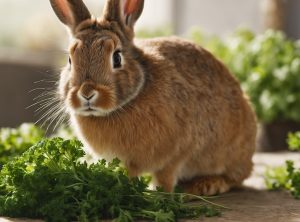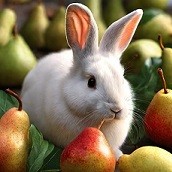Pet Rabbits’ Diet: Fresh Parsley Quantity, Safety & Nutritional Guide

Rabbits: They’re not just the cute, furry creatures that hop around your garden. They’re also pets that require attentive care, especially when it comes to their diet. One common question that I often get is about
Dive in with me as we explore the world of parsley from the perspective of a rabbit’s dietary needs.
The Parsley Plant: An Overview
Before diving into specifics, let’s get a clear understanding of what parsley is. Parsley is a flowering plant native to the Mediterranean but grown worldwide for its aromatic
Roots: The Hidden Delight
What’s Beneath the Surface?
Parsley roots are thick, white to beige in color, and look somewhat like a parsnip. In many cultures, they’re eaten as a vegetable. But, what about for our rabbits?
Safety First!
Good news: Parsley roots are safe for rabbits. However, like any new
Nutritional Punch
These roots are packed with essential nutrients like potassium and fiber. They’re great for a rabbit’s digestive health, and they also help in maintaining a healthy weight.
Stems: The Middle Crunch
Crunchy Goodness
While many of us might overlook the stems and focus on the leafy part, the stems carry their own weight in nutritional benefits.
Can Bunnies Crunch on Them?
Absolutely. Stems are safe for rabbits. But remember, moderation is key. Too much of anything can be less than ideal.
What’s in it for the Bunnies?
Stems provide a good amount of fiber, essential for our rabbit’s gut health. They also contain vitamin K, which aids in bone health and proper blood clotting.
Leaves: The Green Garnish
The Popular Parsley Part
When people talk about parsley, they often mean the leaves. They’re the most widely used part in human dishes, but do rabbits benefit from them as well?
Green Light for Green Leaves
Yes, rabbits can enjoy parsley leaves. They’re not just safe; they’re beneficial. However, balance is vital. Introduce parsley leaves slowly into their diet, and always observe for any changes.
A Nutritional Powerhouse
Rich in vitamins A, C, and K, parsley leaves boost a rabbit’s immune system, improve eyesight, and maintain healthy skin and fur. They also provide antioxidants that help combat cellular damage.
Seeds: Tiny but Mighty?
The Lesser-Known Part
Parsley seeds are tiny and often used as a spice or for germination. But is it advisable for our bunnies?
Proceed with Caution
It’s best to avoid giving parsley seeds to rabbits. Unlike other parts of the plant, seeds can be a potential choking hazard, and there isn’t much documented about their nutritional value for bunnies.
How Much Parsley is Too Much?
After understanding the different parts, the golden question remains: How much parsley can a rabbit eat?
Quantity Matters: A couple of sprigs (including stems and leaves) 2-3 times a week is ideal. As with any vegetable, it should complement their primary diet of
Monitor and Adjust: Each rabbit is unique. Some might handle more parsley than others. Always keep an eye out for any digestive issues or behavioral changes.
Final Thoughts: Embrace Variety
Parsley is a delightful addition to a rabbit’s diet, offering both taste and nutrition. However, the essence of a healthy bunny diet is variety. Rotate between different safe veggies to ensure your pet gets a balanced nutrient profile.
Remember, our bunnies depend on us for their well-being. By understanding their dietary needs, we ensure they lead a healthy, hoppy life. So, the next time your rabbit gives you that inquisitive look, you’ll know exactly how to treat them with some fresh parsley goodness!







Leave a Reply